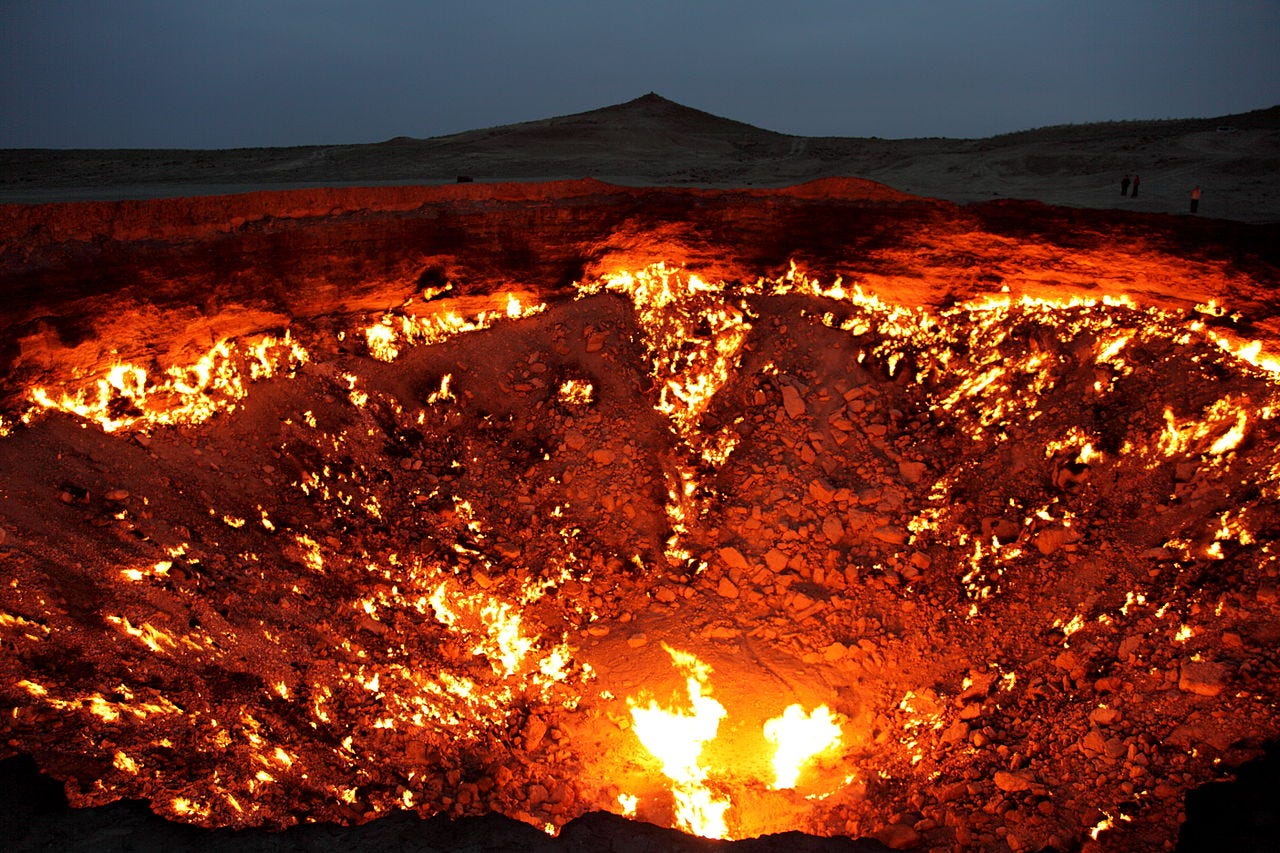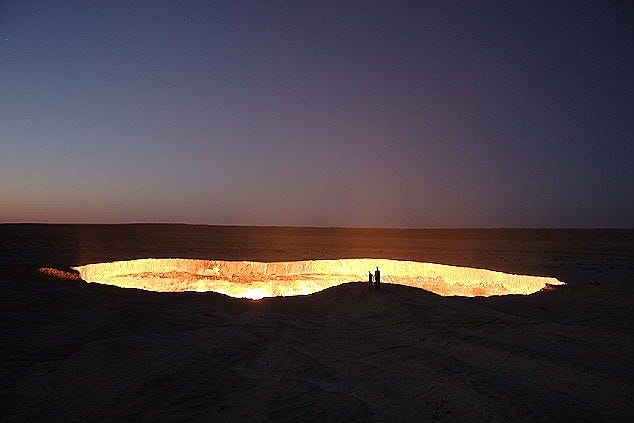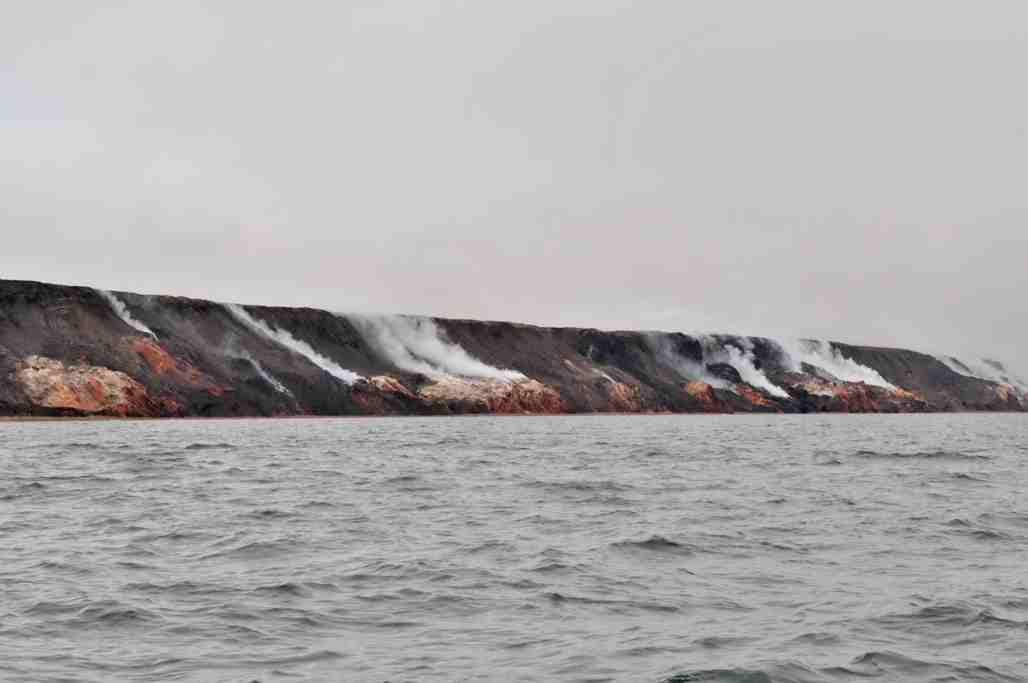In the heart of Turkmenistan's Karakum Desert lies a fiery chasm known as the Darvaza Gas Crater, or more ominously, the "Door to Hell."
This blazing pit (which is also sometimes called the “Gate of Hell”, “Lights of Karakum”, or the “Shining of Karakum”), has been burning incessantly for over five decades, captivating the curiosity of travelers and scientists alike.
Its “origin” dates back to 1971, when Soviet geologists drilling for natural gas inadvertently tapped into a cavern filled with the resource. The ground beneath their rig collapsed, forming a crater approximately 70 meters (~260 feet) wide and 20 meters (~66 feet) deep. To prevent the escape of hazardous methane gas, the geologists ignited it, expecting it to burn out within weeks. Contrary to their expectations, the flames have persisted, fueled by the vast reserves beneath.
…At least, that’s the common story online.
As explorer George Kourounis, who has used heat resistant gear to explore within the crater itself, has pointed out: there is some debate as to the actual origin of the gas fire. The crater may have formed a few years earlier than thought. The fire might have been ignited many years later than thought.
As Jeronim Perovic also points out in this video from the BBC, anything during the Soviet era involving oil, gas, and other natural resources was considered strategic and classified (and, in many cases, we have good reason to believe the Soviets eradicated or hid any record of history that may have painted their national efforts in a negative light).
Even if we don’t really know when the crater formed and we don’t know for sure exactly how long it’s been burning, the fires of the Door to Hell have certainly been burning for several decades.
There has been some consideration of potentially attempting to extinguish the fire. However, it has become a site for tourism for the nation of Turkmenistan (and, heck, I’d love to go visit the crater and then explore more of their country), and it makes sense to allow the fires to continue burning unless some larger geo-engineering infrastructure is planned to control or capture the natural gas otherwise (allowing the methane to flow out into the atmosphere is actually way worse for the world than burning it and forming carbon dioxide—methane is far more impactful as a greenhouse gas than is carbon dioxide).
And so the flames persist.
Eternal Flames and Smoldering Ground
The Darvaza Gas Crater is rather unique, but it isn’t an entirely isolated phenomenon.
There are a number of places around the planet where fires burn from natural fuels underground—such sites are referred to as “eternal flames.”
The Water and Fire Cave in Taiwan is a consistent fire, burning from a methane seep that lies along a fault line. In Azerbaijan, a burning natural gas source known as Yanar Dağ connects modern natural fire with ancient religion and mythology (natural fires from the ground are why Azerbaijan was known historically as “the land of fire”). Baba Gurgur in Iraq has an eternal flame burning from the local near surface oil field that is believe to have been burning for thousands of years (some writers suggest it may be connected to the furnace that King Nebuchadnezzar’s soldiers use in an attempt to burn three men who would not worship a golden idol in the Book of Daniel). In Turkey, the flames of Yanartaş burn on Mount Chimaera and are associated with the mythological story of the fire-breathing chimaera in Homer’s Iliad. And there’s also Eternal Flame Falls in New York, where an underground seep of methane continuously burns (though it sometimes goes out and is restarted by visiting hikers).
Beyond eternal flames from natural gas seeps, there are also other sites where fire is smoldering underground for a variety of other reasons.
For instance, in an episode of Simply Science from Natural Resources Canada, my past collaborator and expert on Arctic geology, Steve Grasby, talks about the Smoking Hills of Cape Bathurst in the High Arctic.
The Smoking Hills are a site where natural underground deposits of oil shale, which is rich in sulfur and carbon from coal, become exposed to the oxygen of our atmosphere and spontaneously ignite. While the smoke was first recorded in the 1800s, it’s believed that the hills have been smoking for millennia.
There’s also a long known phenomenon of “overwintering fires”, also called “peat fires” or “zombie fires”. These fires have been found mostly around the Arctic in regions with organic-rich soils, and they are called “overwintering” as the fires have appeared to burn in surface forests but then go underground to smolder through the winger and reignite at the surface in the next spring. However, some new research has also suggested that some of these fires have a different cause: climate-change induced heating along with microbial activity in the organic-rich material itself may cause the underground fires to start.
One famous site where a specific kind of fire is smoldering underground is Centralia in Pennsylvania—home to a famed coal seam fire.
In this now nearly-abandoned town, a landfill fire that started in 1962 spread to the nearby coal mines below and has been burning ever since. The coal has been burning for nearly 63 years but it’s estimated that the fires could continue burning through the fuel for well over a century and perhaps even more than a quarter of a millennium.
(Fun tangent: there is a modern myth that Centralia was the basis for the eponymous town in the Silent Hill games and films, but this is not true. The original setting had no ties to Centralia at all, even if the first film later took some inspiration from the Pennsylvania town)
There are actually a good number of places around the world where such coal seam fires are actively burning underground. Coal fires in Jharia, India, that started in 1916 are still burning. A coal seam fire started by gunfire by a German battleship in WWII burned for many years by Longyearbyen in Norway’s Svalbard archipelago. And Burning Mountain in Australia has been burning underground for something like 6,000 years (and it could be far older than that).
We also have a number of actively burning underground coal fires here in Colorado. One of the most famous was near the town of Boulder, and happened to be under one of our favorite hiking spots. That fire burned for nearly a century, but recent efforts managed to extinguish the fire just a few months ago.
Watch Where You Step
Eternal flames and smoldering rocks all sound pretty terrifying, but living on a world with abundant oxygen in its atmosphere means fire will happen. Our entire civilization’s history is closely tied to fire. We’ve used fire to clear forests, to heat our homes, to cook our food, to fight with one another… fire is a major part of our past. Using fire was a key step in our use of energy to build our civilization.
The enduring flames of the Darvaza Gas Crater, eternal flames burning around the world, the ghostly remnants of Centralia, and the persistent coal fires of Colorado all serve as reminders of the dynamic and often unpredictable relationship between Earth's geology and the life it supports. They’re also good reminders that sometimes there’s more going on beneath our feet than many people imagine.







Interesting update on Darvaza: the gas fire appears to be dwindling and the flames are now roughly 1/3rd of their original intensity. The fire might be burning out!
https://interestingengineering.com/culture/door-to-hell-to-finally-burn-out-after-54-years